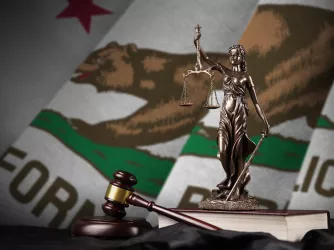Table of Contents
Nude Dancing and the First Amendment Overview

The First Amendment protects much more than the spoken or printed word. It also protects various forms of symbolic speech and expressive conduct. The Supreme Court has ruled that the display of a red flag, the wearing of a black armband, the burning of the American flag and yes, even nude performance dancing are forms of expression that when restricted, require First Amendment review.
The idea that nude performance dancing is a form of free expression may surprise some, but such dancing certainly conveys messages of eroticism. Judge Richard Posner once wrote in a 1990 decision, Miller v. City of South Bend (7th Cir. 1990), that to say nude dancing is not expressive is “indefensible and a threat to artistic freedom.” He explained that expression abounds with disrobing dancers engaged in striptease:
The goal of the striptease—a goal to which the dancing is indispensable—is to enforce the association: to make plain that the performer is not removing her clothes because she is about to take a bath or change into another set of clothes or undergo a medical examination; to insinuate that she is removing them because she is preparing for, thinking about, and desiring sex. The dance ends when the preparations are complete. The sequel is left to the viewer’s imagination. This is the “tease” in “striptease.”
Dance expert, author, and cultural anthropologist Judith Hanna has explained:
Nudity in exotic dance communicates messages of freedom, independence, gender equality, acceptance of the body, modernity, historical tension between how the body was revealed in the past and is revealed now, empowerment, a break with social norms and challenge to the status quo.
The law features a double standard when it comes to nude performance dancing. Nude performance dancing in a play or theater is often respected and unregulated. However, nude dancers at a local gentlemen’s club face a litany of restrictions, such as patron-performer buffer zones, licensing requirements, hours of operations, and even attempts to regulate certain movements.
Supreme Court and Nude Dancing
The Supreme Court first addressed nude dancing in California v. LaRue (1972). In response to complaints about nude dancing at bars, the California Department of Alcohol Beverage Control issued rules regulating the type of live entertainment that could occur in businesses serving alcohol.
The regulations prohibited certain activities at bars serving alcohol, including:
- the performance of acts or simulated acts of intercourse, masturbation, “or any sexual acts which are prohibited by law”;
- the actual or simulated touching of the breast, buttocks, anus, or genitals;
- the public display of the pubic hair, anus, or genitals; and
- the showing of any films or pictures that feature the above-mentioned activities.
When local bar owners challenged the constitutionality of the regulations, the state argued the rules were necessary to prevent sex crimes, prostitution, and drug abuse.
The Supreme Court ruled 6–3 in favor of the regulations. Writing for the majority, Justice William Rehnquist noted that states had broad power to regulate the distribution of alcohol. However, he hinted that some of the dancing in the clubs merited constitutional protection when he wrote that “at least some of the performances to which these regulations address themselves are within the limits of the constitutional protection of freedom of expression.”
The Supreme Court next addressed nude dancing in Doran v. Salem Inn (1975), hinting that at least some such performances merit First Amendment protection. At issue was a North Hempstead, New York ordinance prohibiting waitresses, barmaids, and entertainers from exposing their breasts in public.
The Court ruled that a lower federal court had not erred in granting a preliminary injunction prohibiting the town from enforcing its anti-nudity ordinance. Again writing for the Court, Justice Rehnquist noted, “Although the customary ‘barroom’ type of nude dancing may involve only the barest minimum of protected expression … this form of entertainment might be entitled to First and Fourteenth Amendment protection under some circumstances.”
The Court more squarely addressed the constitutionality of restrictions on nude dancing in Schad v. Borough of Mount Ephraim (1981). The borough of Mount Ephraim, New Jersey, had passed an ordinance prohibiting all live entertainment within its borders. An adult bookstore was charged with violating the ordinance after it began offering live nude dancing in coin-operated booths. The bookstore then challenged the constitutionality of the ordinance, arguing that the banning of non-obscene nude dancing violated free expression rights.
The Supreme Court ruled 7–2 that the ordinance was unconstitutional. Justice Byron White wrote that the borough’s exclusion of live entertainment clearly violated the First Amendment.
The borough argued that the ordinance was merely a zoning regulation that did not target the content of expression and that the law’s purpose was not to restrict expression but to avoid the problems associated with businesses that offer live entertainment, such as parking, trash, and police protection. However, Justice White noted that other permitted businesses would cause the same problems, stating, “We do not find it self-evident that a theater, for example, would create greater parking problems than would a restaurant.”
The Schad decision stands for the principle that cities and counties may not broadly prohibit live entertainment, including nude dancing.
Totally Nude Dancing and the Rise of The Secondary Effects Doctrine
As obscenity prosecutions became harder to win, government officials turned to other ways to regulate adult entertainment, mainly through zoning and licensing restrictions. In Young v. American Mini Theatres (1976) and Renton v. Playtime Theatres (1986), the Court upheld zoning restrictions on adult theaters. In Renton, the Court upheld the law targeting adult businesses under the secondary effects doctrine.
The secondary effects doctrine allows government officials to restrict adult businesses because of the harmful effects of those businesses, most notably increased crime and decreased property values. This doctrine ostensibly allows for content-based restrictions on speech to be treated as content neutral.
In Barnes v. Glen Theatre, Inc. (1991), the Court questioned whether Indiana officials could use the state’s public indecency law to prohibit totally nude dancing at gentlemen’s clubs. In his plurality opinion, Justice Rehnquist wrote that nude dancing “is expressive conduct within the outer perimeters of the First Amendment, though … only marginally so.”
He reasoned that the government’s interest in protecting morals and public safety was unrelated to the suppression of free expression. He said dancers could don G-strings and pasties and still convey their messages of eroticism.
In his concurring opinion, Justice David Souter relied on the secondary effects doctrine as the rationale for upholding the ban on totally nude dancing. He argued that it “is no leap to say that live nude dancing of the sort at issue here is likely to produce the same pernicious secondary effects as the adult films” at issue in Renton.
Nearly a decade later, the Court addressed a similar Pennsylvania ordinance that banned completely nude dancing at strip clubs in City of Erie v. PAP’S A.M. (2000). Writing for the majority, Justice Sandra Day O’Connor used the secondary effects doctrine to justify the ordinance. She reasoned that the ordinance did not target the “primary effects of the expression … but rather the secondary effects, such as the impacts on public health, safety, and welfare.”
Justice Souter dissented in part and candidly admitted that he erred in relying on the secondary effects doctrine in Barnes, writing, “I may not be less ignorant of nude dancing than I was nine years ago, but … I have come to believe that a government must toe the mark more carefully than I first intended.”
Justice John Paul Stevens also dissented. Ironically, it was Justice Stevens who first introduced the secondary effects doctrine in a footnote years ago in American Mini Theatres. Stevens recognized that the Court had extended the secondary effects doctrine to justify regulating the location of adult businesses to “the total suppression of protected speech.”
Conclusion
Nude dancing is a form of expressive conduct that when restricted, requires First Amendment review. However, the Supreme Court has upheld restrictions on totally nude dancing based on the secondary effects doctrine. Thus, in many cities and counties, dancers must don a modicum of clothing, arguably tempering their erotic messages.
Furthermore, lower courts have upheld myriad other restrictions on nude dancing, such as patron-performer buffer zones, licensing restrictions on dancers, and an assortment of other restrictions.
Additional Reading
Hanna, Judith Lynne. Naked Truth: Strip Clubs, Democracy, and a Christian Right. University of Texas Press (2012).
Hudson, David. “The Secondary Effects Doctrine: Stripping Away First Amendment Freedoms.” Stanford Law & Policy Review 23 (2012): 19.
Hudson, David. “Adult Entertainment and the Secondary Effects Doctrine: How a Zoning Regulation May Affect First Amendment Freedoms.” First Amendment Center First Reports 2, no. 1 (2002).
Hudson, David. “Justice Stevens, Justice Souter and the Secondary Effects Doctrine.” University of West Los Angele Law Review 35 (2003): 48.
Hudson, David. “The Secondary Effects Doctrine: The Evisceration of First Amendment Freedoms.” Washburn Law Journal 37 (1997): 55.
Recent Articles
FIRE’s award-winning Newsdesk covers the free speech news you need to stay informed.

FIRE to SCOTUS: TikTok ban violates Americans' First Amendment rights

California and other states are rushing to regulate AI. This is what they’re missing

One day after FIRE lawsuit, Congress passes changes to filming permits in national parks
